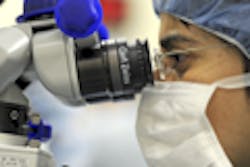As analyzers evolve, so does transfusion medicine
Today, labs face growing pressure to do more with less and produce the most accurate results for the best patient outcomes. These issues are even more severe in blood banking because it is a specialty with one of the highest overall vacancy rates in the United States.1 In part as a response to these pressures, transfusion medicine is experiencing a breakthrough in blood bank solutions.
Immunohematology is the science of blood compatibility, whose application is to ensure that each patient receiving a blood transfusion is matched correctly to the transfusion that he or she receives. Tests to identify antigens and antibodies in both the blood of the donor and the recipient have historically been performed by manual tube techniques, which are time consuming and prone to human subjective interpretation. Due to this limitation, blood banking has focused primarily on identifying those blood type incompatibilities most relevant to patients, because they can cause immediate and potentially fatal transfusion reactions. That’s why the blood types most commonly known are A, B, AB or O, and Rh, whether positive or negative.
Blood analyzers in transfusion medicine
Traditionally, immunohematology testing was done manually. The cells of the donor and the serum of the recipient are mixed together in a single tube, and the blood banker makes a visual assessment to determine the results. Compatibility is determined primarily by whether the cells are clumping together. This approach presents challenges in that the results are subject to human interpretation and error and testing is labor-intensive.
Analyzers were available for testing in other areas of medicine long before they were developed for transfusion medicine about 20 years ago. The technology offered a way to remove human error from testing and improve lab efficiency. The fundamental advantages of blood analyzers are the decrease in labor required and the increase in the consistency and efficiency of results. They may also use computer algorithms to determine results, providing a standardization of measurement.
More recently, analyzers have helped labs optimize their blood bank capabilities, going beyond types and screens to offer a full range of testing, including serial dilutions for titration studies and selected cell panels. They combine secure monitoring technology and dynamic workflow management to enhance accuracy and efficiency. They also provide responsive safety checks and balances to give blood bankers the ability to monitor and record every step of the automated process. There are several different kinds of analyzers for transfusion medicine. Some are designed to respond to challenges unique to each lab with customization features and the adaptability to accommodate unpredictable workflows while reducing the need for batch testing.
Because automation in transfusion medicine has made labs more efficient, it also has helped ease the effect that a lack of specialized technicians has had on the industry. In the past few years, there has been a trend for laboratorians to be generalized. Blood banking, which is critical to the basic function of any hospital, has suffered a particularly serious need for highly trained personnel.
As a result, analyzers have been widely adopted by blood banks in the U.S.; however, this has not been the case in every country around the world. One challenge to incorporating analyzers is the need for a sufficient volume of testing to justify the investment in the instrument. For labs whose volumes do not justify fully automated solutions, semi-automated systems have been created to manually perform the test and use an analyzer to read results. This saves on labor and provides the desired consistency and accuracy even for mid- to low-volume laboratories.
Anticipated breakthroughs
To date, analyzers in immunohematology have primarily addressed efficiency needs such as throughput, cost, and turnaround time. The time has come for the focus to be on improvements that can clinically impact blood recipients. Beyond the ABO and Rh blood typing systems, there are many other antibodies and antigens which can impact patients. It is easy to forget them simply because we don’t routinely test for them all of the time; it would be economically and logistically prohibitive to do so with currently available technology.
Therefore, the next challenge for technology in immunohematology is the offering of clinical improvements for patients, through improved blood matching for as many antigen-antibody combinations as possible.
Such comprehensive immunohematology testing is more critical for some patients than others. There are hundreds of weaker antigens that can cause the development of antibodies that a person may have in their blood. They might not cause a reaction in a patient with a first transfusion; however, that patient’s immune system could build a resistance against any particular antigen. With subsequent transfusions, if the donated blood contains the same antigen, the patient’s reaction could become strong and more serious. Over time, the immune system builds up so much resistance to certain antigens that it becomes very difficult to find blood that will not cause a reaction.
The development of new technologies is underway that will make it possible to test for at least dozens of those weaker antigens and antibodies and provide patients with more compatible blood. This may help avoid the sensitization of patients who need multiple transfusions and promote better outcomes. Furthermore, the technology also will be able to accomplish all this testing in the same amount of time it takes to do less testing today. As technologies advance, labs become more efficient and better able to handle the shortage of specialized staff.
Automation has made immunohematology testing more manageable and reliable. Now, leaders in the industry are driven to continue advancing the technology to provide healthier, safe outcomes for all transfusion patients.
REFERENCE
- Garcia, E, Ali AM, Soles RM, Lewis DG. The American Society for Clinical Pathology’s 2014 Vacancy Survey of Medical Laboratories in the United States. American Journal of Clinical Pathology. 2015;144(3);432-443.
Fernando Chaves, MD, serves as the global head of medical, clinical and scientific affairs for Ortho Clinical Diagnostics. In his role, Chaves is responsible for clinical trials, new product development, and key opinion leader relationships.

